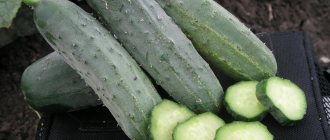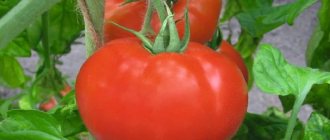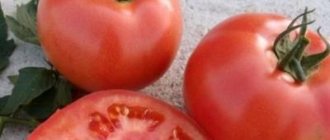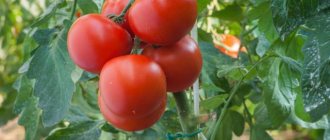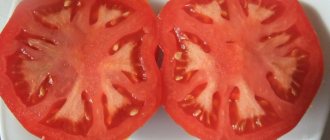Home / Vegetable garden / Tomatoes
Back
Published: November 29, 2018
0
Rate this post
Dutch hybrid tomatoes Polfast are recommended for growing in open ground and greenhouses. This variety is also convenient to plant in greenhouses, under temporary film cover, in order to get an early harvest of tomatoes on your site.
- 1 Advantages and disadvantages
- 2 Tips for growing
- 3 Reviews about tomato
Description of the Polfast tomato: its characteristics, growing region
The Polfast F1 tomato was bred by the Dutch company Bejo Zaden BV, known for creating good varieties and selling seeds of various vegetables. The products of this company are mainly aimed at the European market, but in a significant part of our country the climate is similar to that of Europe. Therefore, some of the seeds end up in Russia, and many gardeners are happy to get acquainted with Dutch varieties. Tomato Polfast was registered in the State Register of the Russian Federation in 2005 and is intended for open ground. It is recommended to grow it in small farms in all climatic regions. In cold climates it can be grown in greenhouses, although due to its short stature this is not the most profitable option.
In terms of ripening time, Polfast is a mid-early hybrid, and in terms of the main purpose of the crop - salad. The first fruits are ready for harvest a little later than three months from the date of emergence. It belongs to the determinate tomatoes, grows in the form of a compact bush, no more than 65 cm high. The root system is well developed. The foliage of the bush is average, the leaves are very large in size and green in color. The fruits are collected in clusters of 4–6 copies.
Polfast tomatoes ripen simultaneously within the cluster
The fruits are medium-sized, weigh from 100 to 150 g, have a flat-round shape with significant ribbing. When fully ripe, they are bright red. They have four or more seed nests, few seeds, and the flesh is firm but juicy. The taste of fresh fruits is sweet and considered excellent. The skin is thin, but quite dense, as a result of which cracking of the fruit is not observed. Tomatoes tolerate transportation well and are stored for a long time. Picked in a state of blanche ripeness, they ripen well at room temperature. In addition to use in salads, they are suitable for any processing options and can be preserved with whole tomatoes. Used for baby and diet food.
Aftercare
Watering
Tomatoes need moderate watering - every 5-6 days. There is no need to overwater the bushes - even in hot weather, plants are able to provide themselves with moisture with the help of powerful roots. It is difficult to dry them out, and excess water leads to root rot and other diseases.
Shaping and tying
Despite the fact that the Polfast f1 variety is determinate, it is still better to remove some excess side shoots. If this is not done, they will grow from the axil of each leaf, which will become too much of a burden for the bush.
It is advisable to form each bush into 3 stems - leave 3 stepsons, turning them over time into strong shoots. If properly formed, the yield from each bush will be at least 5 kg.
These tomatoes do not need tying, due to their compactness and powerful stem. The only thing you need to do is tie up the brushes themselves when the fruits begin to fill. At this time, the support will not harm them, otherwise the grapes will fall under their own weight.
Feeding
| When to fertilize | How to fertilize |
| During planting in the garden | A mixture of leaf humus, ash and ammophoska. Pour in a solution of the preparation “Giant”, “Senior Tomato” |
| After 14 days | Horse or bird manure, superphosphate, ammonium nitrate, ash, urea |
| During the budding period | Solution of pharmaceutical iodine or nitroammophosphate, superphosphate |
| During the period of active flowering | Infusions of nettle, calendula, hawthorn, Kemira Lux, Mortar |
| When setting fruit | "Tamaton", "Ovary", aqueous solution of ash, ammophoska, |
| When pouring fruit | Salt dissolved in water, boric acid, rotted horse manure, potassium sulfate, “Dozrevatel”, “Estrel” |
Appearance of tomatoes
In appearance, the fruits of the Polfast tomato are the same as those of a good third of the known varieties of tomatoes: red, flat-round in shape, medium in size. They are difficult to distinguish from hundreds of similar varieties; belonging to the Dutch hybrids can only be revealed by the correctness of the shape, the absence of deviations from ideal proportions, cracks and tubercles, etc. There is nothing outstanding or unusual in appearance: these are just quite beautiful tomatoes.
In appearance, the fruits are completely classic tomatoes.
Diseases and pests
The Polfast F1 tomato variety is resistant to major diseases. Before sale, seeds are treated with drugs that increase plant immunity. To prevent fungal and viral diseases, young plants can be sprayed with a weak solution of potassium permanganate or phytosporin. At the first signs of late blight, plants are treated with copper-containing preparations.
Simple preventive measures will help prevent diseases : loosening the soil, killing weeds, moderate but abundant watering in warm weather.
Polfast is a good choice for beginning gardeners living in regions with cool climates. Fruit ovaries are successfully formed at low temperatures, and the collected fruits ripen without problems at home.
| Mid-early | Super early | Mid-season |
| Ivanovich | Moscow stars | Pink Elephant |
| Timofey | Debut | Raspberry Onslaught |
| Black truffle | Leopold | Orange |
| Rosaliza | President 2 | Bull forehead |
| Sugar giant | Pickling miracle | Strawberry dessert |
| Orange giant | Pink Impression | Snow fairy tale |
| One hundred pounds | Alpha | Yellow ball |
Advantages and disadvantages, differences from similar varieties
Although the Polfast tomato is more than ten years old, it is still considered a very good choice for lovers of even tomatoes without any special frills of classic shape and color. And although its productivity cannot be considered high, the hybrid never fails and produces what is “supposed” without requiring anything supernatural from the owner. A distinctive feature of the hybrid is a very thin, but at the same time durable skin, which is not felt when eating tomatoes, but allows them to withstand transportation well and be stored in cool rooms. In this regard, the hybrid is used not only by summer residents, but also by farmers who grow vegetables for commercial purposes.
The advantages of the Polfast tomato are:
- high resistance to most known diseases;
- compactness of the bush, making it easier to care for;
- normal tolerance to cold temperatures and drought;
- evenness, “chiseness” of fruits;
- excellent taste;
- early ripeness;
- good transportability and keeping quality of the crop;
- friendly release of the first portion of fruits and continued small fruiting in the future.
Capricious gardeners call the disadvantage that this is a first-generation hybrid, and therefore you cannot sow seeds from your own harvest. But this is the “trouble” of any hybrid tomatoes. In addition, it has been noted that the yield of the hybrid very much depends on the degree of soil fertility.
Features of growing and planting tomato Polfast
The seeds of an early ripening Polfast tomato, in principle, can be sown directly into the garden bed with the arrival of warm weather, but in this case the benefits of early ripening will be reduced to zero. Therefore, almost everywhere the hybrid is grown through the seedling stage. Seeds are sown in boxes in the second half of March; there is no need to prepare them for sowing: they go on sale having already undergone all the necessary treatments.
There are no special features in growing seedlings: seedlings aged 10–12 days can be planted in a common spacious box; if there is a shortage of space on the windowsill, Polfast does not require mandatory individual dwellings. Seedlings, if they are kept cool for a week immediately after the appearance of the first shoots, never stretch out; they are planted in open ground at the traditional time, with the onset of warmth. The compactness of the plants allows you to place up to six plants per square meter of beds.
Polfast tomato seedlings grow strong, you don’t have to plant them tilted
Watering and fertilizing regimes do not differ from those procedures in the case of most early ripening varieties. The fruits of this hybrid do not crack, but as they begin to turn red, the plants are watered less frequently and less so that the tomatoes gain sugar and become tastier. The feeding scheme is traditional three times a day.
Growing Tips
The peculiarities of growing the early ripening variety Polfast lie in the timing of sowing seeds for seedlings. By the time of planting in a permanent place, the seedlings must be 2 months old. Seeds are sown in previously prepared and disinfected soil. The embedment depth should not exceed 0.5 cm.
Seeds germinate well at a temperature of +25°C. In conditions of high temperature and humidity, seedlings will appear in 4-5 days. When 2-3 true leaves grow on the bushes, they need to be planted at a distance of 10 cm from each other. Subsequent care of seedlings consists of regular watering.
1 week after planting tomatoes in a greenhouse or garden, you need to fertilize. Complex fertilizer for tomatoes (Agricola, Signor Tomato, etc.) is diluted in water according to the instructions and watered at the roots of the bushes. Fertilizing is repeated when the Polfast tomato begins to bloom.
The main care during the fruiting period is to properly water the plants. Tomatoes need to be watered when the top layer of soil dries 2-3 cm, approximately once every 5-7 days. Excessive watering makes the sweet taste of the fruit less intense.
The variety is resistant to verticillium and fusarium wilt, and is not susceptible to late blight infection. Treatment with pesticides is not carried out.
Reviews from gardeners about Polfast tomatoes
Today I picked my first red Polfast tomatoes. Exactly four months have passed since the seed was planted in the ground, in a glass. In terms of timing, it's three weeks late. Due to planting ungrown, month-old seedlings. Plus no maintenance.
Curious
https://dacha.wcb.ru/index.php?showtopic=38020&st=20
I planted the Polfast hybrid last year. I really liked the good set and yield, but the packers got carried away with the most delicate taste. Normal taste typical of red hybrids.
Sweet
https://www.tomat-pomidor.com/forums/topic/3203-%D0%BF%D0%BE%D0%BB%D1%84%D0%B0%D1%81%D1%82-f1/
I also planted Polfast F1 last year. In the cold summer I was not pleased with the early ripeness (although I knitted well, I was in no hurry to blush). I didn’t particularly remember the taste (there were already other ripe varieties). Went for processing. The first tomatoes were up to 200 grams, then smaller. I remember that it tolerates transportation well and can lie down for a couple of weeks.
Lily
https://www.tomat-pomidor.com/forums/topic/3203-%D0%BF%D0%BE%D0%BB%D1%84%D0%B0%D1%81%D1%82-f1/
Tomatoes for open ground "Polfast". The bush is low, compact, sparsely leafy, and also surprised with its productivity.
Irina
https://www.nn.ru/community/dom/dacha/kakie_pomidory_my_sazhaem.html
I planted Polfast F1 in OG - productive, early, equal in size, tasteless, or rather tasteless, like most early tomatoes, I abandoned this variety. It’s better to do it later, but it will be tastier, since the area for a vegetable garden is limited.
Arken
https://forum.vinograd.info/showthread.php?p=597168
